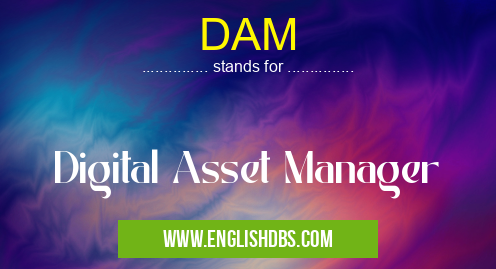What does DAM mean in UNCLASSIFIED
DAM stands for Digital Asset Manager. It is a software or system that helps organizations manage, organize, store, and find their digital assets. These assets can include images, videos, audio files, documents, and more.

DAM meaning in Unclassified in Miscellaneous
DAM mostly used in an acronym Unclassified in Category Miscellaneous that means Digital Asset Manager
Shorthand: DAM,
Full Form: Digital Asset Manager
For more information of "Digital Asset Manager", see the section below.
What Does DAM Mean
DAMs are used to centralize and streamline the management of digital assets. They provide a single repository for all digital assets, making them easy to find, share, and use. DAMs also help to ensure that digital assets are used consistently and in accordance with copyright and other legal requirements.
DAM Full Form
The full form of DAM is Digital Asset Manager.
Benefits of Using a DAM
There are many benefits to using a DAM, including:
- Centralized storage: All digital assets are stored in one central location, making them easy to find.
- Improved organization: DAMs help to organize digital assets into folders and categories, making them easy to find.
- Increased productivity: DAMs can help to streamline the workflow for finding and using digital assets, which can save time and increase productivity.
- Reduced costs: DAMs can help to reduce costs by eliminating the need to duplicate digital assets or purchase new ones.
Essential Questions and Answers on Digital Asset Manager in "MISCELLANEOUS»UNFILED"
What is a Digital Asset Manager (DAM)?
A Digital Asset Manager (DAM) is a software solution that helps organizations manage, organize, and distribute digital assets such as images, videos, documents, and audio files. It provides a centralized platform for storing, retrieving, and sharing digital assets across teams and departments.
What are the benefits of using a DAM?
DAMs offer numerous benefits, including:
- Improved asset management: Centralized storage and organization for easy asset retrieval.
- Increased efficiency: Automated workflows and search capabilities for faster asset retrieval and sharing.
- Enhanced collaboration: Shared access and version control for seamless team collaboration.
- Improved security: Controlled access and permissions to ensure asset protection.
- Brand consistency: Ensures consistent use of brand assets across channels.
What types of digital assets can be managed in a DAM?
DAMs can manage a wide range of digital assets, including:
- Images (JPEG, PNG, TIFF, etc.)
- Videos (MP4, MOV, AVI, etc.)
- Documents (PDF, DOCX, XLSX, etc.)
- Audio files (MP3, WAV, AIFF, etc.)
- 3D models
- Presentations
- Marketing materials
How do I choose the right DAM for my organization?
Consider the following factors when selecting a DAM:
- Asset volume and complexity: The number and types of assets you need to manage.
- Integration requirements: Compatibility with your existing systems and workflows.
- Security and compliance: Ensure the DAM meets your security and regulatory requirements.
- Scalability: The ability to grow and meet future needs.
- User experience: Ease of use and adoption by your team.
What is the difference between a DAM and a PIM?
A Digital Asset Manager (DAM) focuses on the management and distribution of visual and multimedia assets, while a Product Information Management (PIM) system manages structured data related to products, such as product descriptions, specifications, and pricing.
Final Words: DAMs are essential tools for organizations that need to manage digital assets. They can help to save time, increase productivity, and reduce costs.
